
Berthold of Hanover (died 24 July 1198) was a German Cistercian and Bishop of Livonia, who met his death in a crusade against the pagan Livonians.

Berthold of Hanover (died 24 July 1198) was a German Cistercian and Bishop of Livonia, who met his death in a crusade against the pagan Livonians.
He was abbot of the Cistercian Loccum Abbey in Hanover. At the death of Saint Meinhard, the first Bishop of Livonia (c. 1196), Hartwig of Uthlede, Archbishop of Bremen, to whose province belonged the newly converted countries along the eastern shores of the Baltic Sea, appointed Abbot Berthold successor. Damberger asserts [1] that when Meinhard came to Bremen in 1186 to obtain help with his mission in Livonia, Berthold joined the band of missionaries who accompanied him there.
The Livonian pagans were fanatically opposed to Christianity. Berthold's predecessor, assisted by merchants from Bremen and Lübeck and a few converts, had built fortifications along the River Düna, where Christians held their religious services and could protect themselves. Following in the footsteps of his predecessor, Berthold tried to gain confidence and good will by kindness. At first the pagans appeared to become less hostile, but soon their old hatred revived. When Berthold attempted to bless the Christian cemetery at Holm, they decided either to burn the bishop together with his church at Holm or to drown him in the Düna. The Christians fled to their strongholds at Üxküll and Holm, while the bishop escaped in a ship to Lübeck.
Pope Celestine III, shortly before his death, was preparing to send a fleet of crusaders to protect the Christians of the Baltic Provinces, and his successor, Pope Innocent III, continued the work. Berthold gained the financial assistance of Archbishop Hartwig and many merchants of Bremen and Lübeck. In a short time a large fleet was ready for departure, well equipped and loaded with crusaders and many German peasants who were to settle permanently in Livonia. It put to sea at Lübeck and crossed the Baltic, entering the River Düna from what is now called the Gulf of Riga. Near the mouth of the Düna the German peasants landed with the purpose of making their homes in the vicinity, and laid the foundations of the city Riga. Berthold, accompanied by the crusaders, sailed up the river as far as Holm, where the Livonians had gathered with the intention of attacking the fleet.
Having failed to come to a peaceful agreement with them, Berthold and his companions sailed some distance down the river, with the Livonians in pursuit. The pagans agreed to a truce, to gain time, but they attacked the Christians who ventured outside their fortifications, and hostilities were resumed. The crusaders were victorious, but Berthold's horse became intractable and galloped into the midst of the fleeing Livonians. A pagan by the name of Ymaut [2] (wrongly read as Ymant) [3] thrust his lance into Berthold's back, inflicting a wound that caused speedy death.
The bishop's body was buried by the crusaders at Üxküll, and was later transferred to Riga by Albert of Riga, whom Archbishop Hartwig of Bremen had appointed Berthold's successor. After the death of Berthold some of the conquered pagans asked to be baptized. The final conversion of Livonia was effected by Bishop Albert, who was assisted in by the newly founded Order of the Brothers of the Sword, which in 1237 was affiliated with the Teutonic Order.
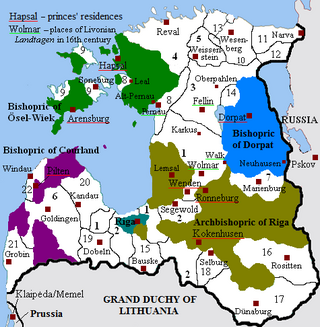
Livonia or in earlier records Livland, is a historical region on the eastern shores of the Baltic Sea. It is named after the Livonians, who lived on the shores of present-day Latvia.
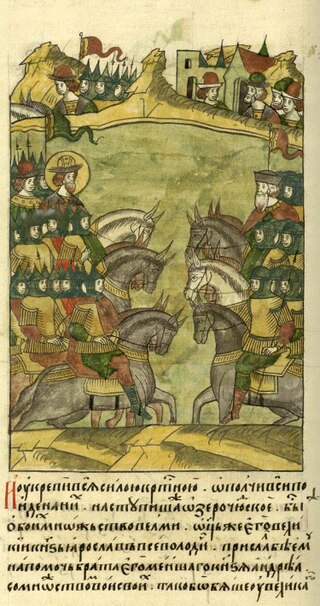
The Northern Crusades or Baltic Crusades were Christianization campaigns undertaken by Catholic Christian military orders and kingdoms, primarily against the pagan Baltic, Finnic and West Slavic peoples around the southern and eastern shores of the Baltic Sea, and also against Orthodox Christian East Slavs.

Saare County is one of 15 counties of Estonia. It consists of Saaremaa, the largest island of Estonia, and several smaller islands near it, most notably Muhu, Ruhnu, Abruka and Vilsandi. The county borders Lääne County to the east, Hiiu County to the north, and Latvia to the south. In 2022 Saare County had a population of 31,292, which was 2.4% of the population of Estonia.

The Livonian Chronicle of Henry is a Latin narrative of events in Livonia and surrounding areas from 1180 to 1227. It was written c. 1229 by a priest named Henry. Apart from some references in Gesta Danorum – a patriotic work by the 12th-century Danish historian Saxo Grammaticus – and few mentions in the Primary Chronicle compiled in Kievan Rus', the Chronicle of Henry is the oldest known written document about the history of Estonia and Latvia.

The Livonians, or Livs, are a Balto-Finnic people indigenous to northern and northwestern Latvia. Livonians historically spoke Livonian, a Uralic language closely related to Estonian and Finnish. Initially, the last person to have learned and spoken Livonian as a mother tongue, Grizelda Kristiņa, died in 2013, making Livonian a dormant language. In 2020, it was reported that newborn Kuldi Medne had once again become the only living person who speaks Livonian as their first language. As of 2010, there were approximately 30 people who had learned it as a second language.
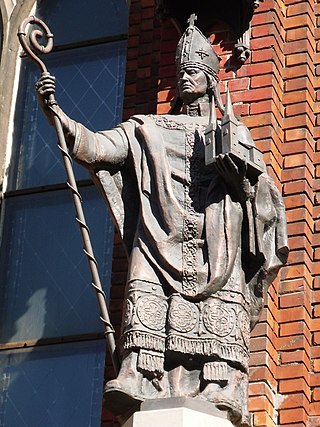
Albert of Riga or Albert of Livonia was the third Catholic Bishop of Riga in Livonia. In 1201, he allegedly founded the city of Riga, the modern capital of Latvia. The building of the Riga Cathedral started during his tenure there in 1221.

William of Modena, also known as William of Sabina, Guglielmo de Chartreaux, Guglielmo de Savoy, Guillelmus, was an Italian clergyman and papal diplomat. He was frequently appointed a legate, or papal ambassador by the popes Honorius III and Gregory IX, especially in Livonia in the 1220s and in the Prussian questions of the 1240s. Eventually he resigned his see to devote himself to these diplomatic issues. On 28 May 1244 he was created Cardinal-Bishop of Sabina by Pope Innocent IV. For a short time (1219–1222) he served also as Vice-Chancellor of the Holy Roman Church.

Albert Suerbeer was the first Archbishop of Riga in Livonia.

Ikšķile is a town in Latvia, in Ogre Municipality. It was the first capital of the Roman Catholic Bishopric of Livonia, known by the German name of Üxküll. Saint Meinhard was the first bishop of Üxküll. In 1197, Berthold of Hanover, a Cistercian abbot of Loccum, was made the second bishop of Üxküll. Those days the town was the center of the upcoming crusading activities in the Livonian area. Bishop Berthold moved the episcopal see to Riga, before being killed by the Livs in battle.
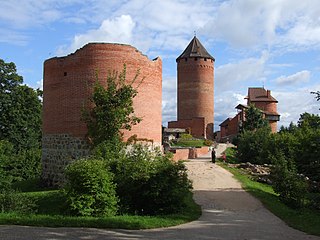
Turaida Castle is a recently reconstructed medieval castle in Turaida, in the Vidzeme region of Latvia, on the opposite bank of the Gauja River from Sigulda.

Oeselians or Osilians is a historical name for the people who prior to the Northern Crusades in the 13th century lived in the Estonian island of Saaremaa (Ösel) – the Baltic Sea island was also referred as Oeselia or Osilia in written records dating from around that time. In Viking Age literature, the inhabitants were often included under the name "Vikings from Estonia"., as written by Saxo Grammaticus in the late 12th century. The earliest known use of the word in the (Latinised) form of "Oeselians" in writing was by Henry of Livonia in the 13th century. The inhabitants of Saaremaa (Ösel) are also mentioned in a number of historic written sources dating from the Estonian Viking Age.

The Livonian crusade consists of the various military Christianisation campaigns in medieval Livonia – modern Latvia and Estonia – during the Papal-sanctioned Northern Crusades in the 12–13th century. The Livonian crusade was conducted mostly by the Holy Roman Empire and the Kingdom of Denmark. It ended with the creation of Terra Mariana and the Danish duchy of Estonia. The lands on the eastern shores of the Baltic Sea were one of the last parts of Europe to be Christianised. The available information is largely based on Livonian Chronicle of Henry.

The history of Riga, the capital of Latvia, begins as early as the 2nd century with a settlement, the Duna urbs, at a natural harbor not far upriver from the mouth of the Daugava River. Later settled by Livs and Kurs, it was already an established trade center in the early Middle Ages along the Dvina-Dnieper trade route to Byzantium. Christianity had come to Latvia as early as the 9th century, but it was the arrival of the Crusades at the end of the 12th century which brought the Germans and forcible conversion to Christianity; the German hegemony instituted over the Baltics lasted until independence—and is still preserved today in Riga's Jugendstil architecture.
Hartwig of Uthlede was a German nobleman who – as Hartwig II – Prince-Archbishop of Bremen and one of the originators of the Livonian Crusade.
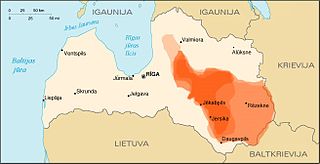
The principality of Jersika was an early medieval Ruthenia principality in eastern modern-day Latvia and one of the largest early states in Latvia before the Northern Crusades. The capital of Jersika was located on a hill fort 165 km (103 mi) southeast of Riga.
Valdemar Knudsen was a Danish clergyman and statesman. Valdemar was Bishop of Schleswig from 1188 to 1208, officiated as Steward of the Duchy of Schleswig between 1184 and 1187, and served as Prince-Archbishop of Bremen from 1192 to 1194 and again between 1206 and 1217. He held the latter office on the grounds of the archdiocesan capitular election as archbishop elect and of the royal investiture with the princely regalia, but lacked the papal confirmation.

Saint Meinhard was a German Augustinian canon regular and the first Bishop of Livonia. His life was described in the Chronicle of Henry of Livonia. His body rests in the now-Lutheran Riga Cathedral, as his remains were moved to Riga in 1226. He is venerated as the apostle of the Church in Latvia.

The Curonians or Kurs were a medieval Baltic tribe living on the shores of the Baltic Sea in the 5th–16th centuries, in what are now western parts of Latvia and Lithuania. They eventually merged with other Baltic tribes contributing to the ethnogenesis of present-day Latvians and Lithuanians. Curonians gave their name to the region of Courland (Kurzeme), and they spoke the Curonian language.

Terra Mariana was the official name for Medieval Livonia or Old Livonia. It was formed in the aftermath of the Livonian Crusade, and its territories were composed of present-day Estonia and Latvia. It was established on 2 February 1207, as a principality of the Holy Roman Empire, and lost this status in 1215 when Pope Innocent III proclaimed it as directly subject to the Holy See.
Baldwin of Alna was Pope Gregory IX envoy and later Papal legate in Baltic region. He participated in both Northern Crusades and crusades to the East.